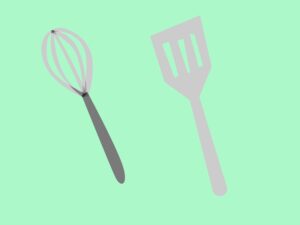Writing by Emily Meehan
Artwork by Justin Negard
Are your kitchen drawers overflowing? Does your produce never last? Are you struggling to understand why your pasta and sauce act like opposing magnets? And are you too embarrassed to ask or don’t know who to ask? It’s okay – we’ve got you. These food (and beverage) tips and tricks will take you from novice to knowledgeable faster than you can boil a pot of water.

You don’t need a lot of kitchen gadgets
As a professional personal chef, Suzy Chin is no stranger to the kitchen. As a pro, she says all you really need is a reliable set of pots and knives.
“Your knife is something that you will use daily, and it should be nice and sharp,” she advises. “I sharpen my knives daily, and I take them to a professional twice a year.”
Then, with the right mindset, you can turn your basic kitchen tools into creative gadgets.
“When you’re rolling a pizza and you don’t have a rolling pin, you can use a bottle of wine,” Chin suggests.
She has also found that you can use the end of a rolling pin to muddle or crush ingredients, such as mint leaves.
And really, it’s not necessary to spend money on cooking gadgets. Even things that appear useful, like a garlic peeler tube, aren’t that necessary.
“It’s a good concept, but it just takes up drawer space,” she explains.“Also, lemon squeezers. You think, ‘I could use that. That looks really cool.’ Right? But you can just use a fork, which works the same.”
And if you’re attempting to cook with your children, give them the real stuff.
“Kids want to mimic their mom or the cook in the kitchen,” Chin says. “I give them things like wooden spatulas, plastic tools or the silicone brush.”

How to make your own pasta
If you have the time, try making fresh pasta at home.
“Fresh pasta is softer and absorbs sauce better because it’s more porous than boxed pasta,” says Maria Abbate, co-owner of Katonah Pasta. “But to be fair, there are some really good box pastas that are air-dried instead of forced-dried. Apparently, when they force-dry pasta, they use radiation, which is really bad for the integrity of the pasta.”
The amount of time it takes will depend on the person. Abbate says her sister-in-law can, “probably do it in 30 minutes, but it could take some people hours,” so clear your afternoon if you’re a beginner.
If you do have a few hours to spend making pasta, quality ingredients are a must.
“A better quality flour makes the pasta softer, and a coarser flour makes the pasta harder,” Abbate explains. “If it’s coarser, it won’t stick to itself as easily. It’s also based on what country the flour is from because different countries have different standards. I prefer European flour over American flour.”
And when you’re done making and cooking your fresh pasta, the flavor is so distinct that you won’t need to spend a lot of time creating a complicated sauce.
“When it comes to a pasta sauce, I think it should be simple so that you can really taste the pasta,” says Abbate. “Like oil and grated cheese and a simple vegetable. I’m all about simple.”

Why you should make your own pasta sauce
Your ingredient choices make a big difference.
When it comes to making a tomato sauce, “you always make sure that the tomato is not too watery or too thick – it has to be just right,” says Antonio Abbate, co-owner of Le Fontane in Katonah.“If it’s too watery, you turn up the flame a little bit and cook it until that water evaporates and you get a good consistency.”
Abbate also says that one special ingredient can change the composition of your sauce.
“There’s one tomato called San Marzano tomato, and you see it everywhere in the world,” he says. “It grows in Campania, Italy at the bottom of Mount Vesuvius, outside of Naples. The land, the soil and the sun make it special. Because the tomato doesn’t have much water, it’s very rich and the sauce made from it is very good.”
And to make sure your sauce sticks to the pasta, save your pasta water.
“You can add your pasta water because when you cook the pasta, it leaves a little bit of starch behind that then helps to stick the pasta to the sauce,” he explains.“Add a little bit at a time – not much, so if you need more, you put more. It takes some practice, but eventually, after a couple of times, it comes automatically.”
Some people enjoy adding cheese to their sauce for a pop of flavor. What you might not know is that, “Parmesan cheese is another ingredient that can help a little bit with getting pasta to stick to sauce. Some people may use corn starch, but we don’t use anything like that. We only cook pasta sauce naturally.”

When to buy produce, meat and dairy products
Most grocery stores restock as needed throughout the week. Although the day of week that you shop doesn’t matter much, the time of day that you purchase meat, dairy and produce does.
“The best time of day to purchase meat, dairy and produce would be around 10:00 a.m.,” says Chin, the personal chef. “That’s when most grocery stores are fully stocked.”
Buying these products in the morning, as a rule of thumb, is also applicable for those who shop at farmers markets. She says that by the afternoon, most of the greens are wilted.
“Look at the ends of vegetables to see if they have wilted,” Chin recommends. “With fruit, they should be firm, not soft.”
Additionally, a sweet smell indicates fruit is at its optimal time.
The freshness of meat can also be gauged with your eyes and nose.
“When meat starts to turn a brownish color, it means it’s been exposed to oxygen for too long”, says Chin. “A foul odor is the easiest way to indicate old meat. You can smell it, even through the plastic wrap.”
Chin recommends making a meal plan for the week so that you know when to buy your meat.
“You should buy meat at least four days before the expiration date.”
She recommends bringing a cooler when purchasing meat because “as soon as you take it out of refrigeration, the spoiling process starts.”

How to buy and store fish
When buying fish, you should always check its country of origin.
“I really prefer to keep all my fish local, but sometimes you can’t,” says Joe DiMauro, owner of Mt. Kisco Seafood.
Years ago, it was unwise to purchase fish on a Monday because fishermen hadn’t been out on the water for several days. And although the fishing market has changed, it’s still wise to check when your fish arrived at the store.
“Right now, people fish every single day because there’s so much competition,” DiMauro explains. “But, you still have to be really careful because there’s a lot of crap that’s left over from Friday.”
According to DiMauro, you can assess the freshness of a fish just by looking at it. One of the initial signs to look for is fish with crystal clear eyes. Additionally, “the gills should be cherry bright red, and if the fish is gutted, the blood inside should be bright red.”
“Every fish has different tells,” he continues. “For example, a swordfish comes in many different colors and hues, but the center part, the dark part of the fish, should be either a cherry red or bright red. It shouldn’t be brown or tan or gray.”
Once purchased, store your fish properly to avoid spoiling and health concerns. At Mt. Kisco Seafood, they keep their fish in a cooler set in the low to mid 30s.
“Temperature is very important,” DiMauro stresses.
Properly storing fish can prolong its freshness.
“If you’re looking to store fish for two days, it can go right into the coldest part of the refrigerator – your vegetable crisper,” DiMauro says. “But, if you’re going to keep it for longer, you really have to talk to your fishmonger. Then we’ll freeze-wrap it for you.”
To avoid buying fish that are part of an endangered group, buy from reputable sellers. For example, DiMauro says that people ask him why he doesn’t sell Chilean sea bass.
“Well, because it’s been on the watch list for the last 15-18 years,” he explained.

Exploring the world of beer
When it comes to beer, you have a range of options.
“There are all kinds of different beers,” says Nick Linares, general manager of Captain Lawrence Barrel House in Mount Kisco. “There are ales and lagers –that’s kind of the base distinction. But then, different regions of the world have their own distinctions, so overall, there are tons of different styles.”
For people just starting to explore beer, Linares recommends starting out with a softer flavor.
“Start with something like a light lager because it’s very easy to drink,” he suggests. “We call our classic lager beer-flavored beer.”
As you begin to experiment, you’ll figure out what you do (and don’t) like.
“Usually IPAs carry a bitterness that people tend to not like right off the bat,” Linares says. “Then once you start to experiment more with beer, different styles will introduce bitterness to you.”
The last, and most important step, is discovering the perfect meals to pair with your preferred beer.
“Pairing our pale ale with pretzels is a popular choice,” he says. “Another good go-to here is a light lager or Kölsch with some chicken wings.”

The best way to store wine
Wine reacts to its environment, so one of the most important ways to prevent it from going bad is to store it properly.
“Generally, you never want to get above 70 degrees because then it gets too warm,” explains Enrico Dinardo, owner and executive chef of Il Forno in Somers. “The optimal wine storage temperature is usually between 45 and 65 – 55 is ideal. You also want to avoid a lot of exposure to excess light sources, like sunlight.”
“If it has a cork,” he continues, “you should leave it on its side so that the cork doesn’t dry out. And if you’re keeping expensive wine for a long time, you want it to be in an environment with very little humidity. Again, so that the cork doesn’t dry up. You want to move the wine as little as possible and avoid drastic temperature changes.”
Even without a fancy cellar, you can still make accommodations to keep your wine fresh. Basements will often suffice.
“Usually, basement temperature doesn’t fluctuate as much,” Dinardo explains. “But stay away from storing it in your kitchen because there’s always temperature changes. Additionally, if you put wine in a box with sand, the sand helps control the temperature variation a little more; it’s kind of like a homemade cellar.”
You can also store wine in the refrigerator, but not permanently.
“Generally, as a rule of thumb, you don’t want to keep your wine in the refrigerator for more than a year,” he recommends. “The refrigerator’s optimal temperature is 42 degrees, which would leave the wine below that optimum storage temperature of 55 for a long period of time.”
Even after being opened, there are still ways to preserve wine. Open wine usually lasts up to 24 hours. Dinardo has found that, “with red wines, if you open and close them right away and put them in a refrigerator to take out a half hour before you want to serve it, it tends to hold on longer.”
This article was published in the July/August 2023 print edition of Katonah Connect.

Emily Meehan
Emily Meehan is a college student who is passionate about music, art and writing.










